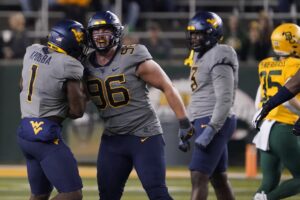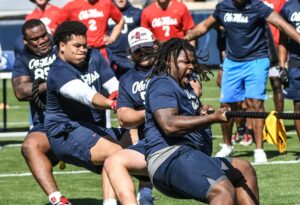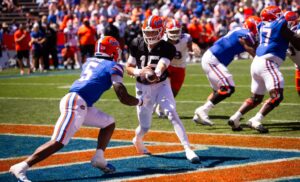After a wild season opener, the question has to be asked: “Where can Notre Dame improve?”
It was a far cry from a perfect effort in the Irish’s 41-38 overtime victory over Florida State. From the offense stalling out in the fourth quarter, to a late defensive meltdown, there were plenty of questions. Against Toledo, the Irish ought not measure their success by the result, but rather by tangible on-the-field improvements. As the Irish enter a pair of games they should win comfortably, what should Notre Dame fans be looking for to signify improvements entering a brutal five-game stretch.
How Can Notre Dame Improve?
Establish The Run Game
The Irish couldn’t do much on the ground against Florida State. After running backs Kyren Williams and Chris Tyree torched the Seminoles for 288 yards in 2020, the duo struggled in this year’s opener. They combined for 73 yards on 25 carries, putting most of the weight on quarterback Jack Coan’s shoulders. While Coan responded with a dynamic effort, the Irish will need more from their backs and offensive line. Against Toledo, look for the Irish to try and establish that power run game with two-back sets, multiple-tight end looks, establishing more of a balanced identity for their offense.
Avery Davis?
Avery Davis is Notre Dame’s top returning receiver. And while it was a generally positive effort from the receiving corps on Sunday, Davis was basically invisible. The former quarterback was on the field for 57 of 72 offensive snaps, leading all receivers. Yet he didn’t reel in a single reception. The Irish don’t need Davis to be a No. 1 guy, particularly if Kevin Austin continues to show out. But on a night when Austin, Braden Lenzy, and Joe Wilkins combined for seven catches, 153 yards, and two touchdowns, Davis’s absence on the stat sheet was noticeable.
If fans want to see Notre Dame improve even more in the passing game, having every receiver in this unproven corps performing well is critical. A nice effort against Toledo would go a long way for Avery Davis and the Irish offense.
Michael Carmody Stepping Up
Michael Carmody did not necessarily struggle individually against Florida State. He was thrust into a starting role when freshman Blake Fisher sprained his knee. However, the Irish were tormented by an athletic defensive front, with poor run blocking and even shaky pass protection. With a much less mobile quarterback in Coan, better protection will be key down the stretch. And in the run game, Carmody will be a key player, as he’ll occupy the left side of the line. Notre Dame loved to run the ball to the left side last year, utilizing strong line play and tight end blocking. With Fisher out for six weeks, Notre Dame needs Carmody to step up and give them that option again. Virginia Tech, UNC, USC, Wisconsin, and Cincinnati make up that brutal five-game stretch for the Irish. Those teams gave up 12.4 points per game on average in Week 1. Florida State is not going to be the toughest defense on the schedule.
Can Notre Dame improve Special Teams’ Play?
Outside of Jonathan Doerer’s heroics, there were some significant issues on special teams for the Irish. They have one of their best athletes in Chris Tyree returning kickoffs, yet he fair caught everything. The Irish don’t need Tyree risking injury, or returning from deep in the end zone. But when the fastest player on your team is fair-catching from the two-yard line? Notre Dame just accepted average field position, which is frustrating with an athlete like Tyree fielding kickoffs. Maybe it was poor coverage – but either way, it’d be nice to see Tyree try and break off an explosive return against Toledo.
The punting game also struggled at times. While Jay Bramblett did well early in pinning the Seminoles deep, he struggled with flipping the field, averaging under 40 yards per punt. A particularly short effort in the first half led to a short Florida State drive and score. Bramblett has been exceptionally reliable, but he had some duds against the Seminoles. Ideally, Notre Dame won’t punt much against Toledo. But if and when they do, getting Bramblett would be a nice bonus for the Irish.
No Big Plays
There was a lot to like and dislike about Notre Dame’s defensive effort. Through three quarters, the Irish gave up just 20 points. One was caused by the aforementioned short field. However, the other two came via familiar issues for the Irish defense – big plays. First there was the 89-yard run for the first Seminole score. Then a 60-yard pass in the third quarter that gave Florida State a 20-17 lead. After an offseason hypothesizing how new defensive coordinator Marcus Freeman would help Notre Dame improve in this area, the first game was not promising.
No Three-Man Pass Rushes
Marcus Freeman didn’t call for complete “Prevent” defense in the third quarter, but it was close to it. Facing a quarterback that had struggled to pass all night, the Irish put just three men on the line and dared the Seminoles to run the ball. Which they did, as it was their major strength all night. The Seminoles ran the ball down Notre Dame’s throat and scored a momentum-changing touchdown early in the fourth quarter. A game that was 38-20 became a 10-point battle, and the Seminoles ultimately tied it.
Notre Dame brought fantastic pressure for most of the game, They notched five sacks and forced Jordan Travis and McKenzie Milton out of the pocket frequently. On one hand, it’s reassuring that most of Notre Dame’s defensive struggles can be attributed to a scheme issue. On the other hand, it was concerning to see Freeman become so passive in protecting the lead. When the Irish dialed the pressure up in overtime, it went exceptionally well and helped seal the victory. Against Toledo, domination should be expected. The Rockets are not a solid but not great MAC team. Their offensive weapons are good but not necessarily remarkable. A nice sign of improvement would be to see Freeman keep his foot on the gas. Shoot for the shutout, keep the pressure coming, and don’t let a big lead change your scheme.
Three Things Notre Dame Should Keep Doing
Taking Downfield Shots
After a year void of them, the Irish finally took some deep shots downfield against the Seminoles. Some worked, like a long touchdown pass to Kevin Austin on 3rd and 1. Others didn’t, like a first-quarter flea-flicker that was nearly picked off. Some were just defended well, like a deep look for Lenzy that was batted away at the last second. But Notre Dame has the athletes this year, and a quarterback who flashed a pretty nice deep ball. There’s no reason not to take those shots, and it could allow Notre Dame to put up some quick scores and bigger numbers.
Causing Turnovers
Last year, it took almost three full games for Notre Dame to record an interception. All-American safety Kyle Hamilton had just one all season. On Sunday, the Irish had three, with two coming from Hamilton. One of the keys to 2021 was seeing Notre Dame improve their secondary play, and the Irish delivered on Sunday. Keep making quarterbacks uncomfortable and winning turnovers – opportunistic defenses are tough to beat late in the season.
Blitzing Linebackers
One of the highlights of Freeman’s Notre Dame debut was his blitz packages involving linebackers. Freeman utilized one of the deepest parts of his depth chart to wreak havoc in the backfield. Captain Drew White was constantly applying pressure. He finished with 5.5 tackles and was inches from several sacks. J.D. Bertrand broke through unblocked in overtime, pressuring Milton into an incomplete pass that led to the field goal miss. Bertrand also led the team with 8.5 tackles. Outside of some questionable scheme decisions, Notre Dame’s defense played far better than the 38 points on the scoreboard allowed, and the linebacker room was a big part of that.






